Thermal and Sound Characterization of a New Biocomposite Material
Abstract
:1. Introduction
Literature Review
2. Materials and Methods
2.1. Material
- Biocomposite P: Sawdust 53.5%, styrofoam 13.5%, lime 26.5%, gypsum 6.5%;
- Biocomposite K: Corncobs 53.5%, styrofoam 13.5%, lime 26.5%, gypsum 6.5%;
- Biocomposite M: Sawdust 26.75%, corncobs 26.75%, styrofoam 13.5%, lime 26.5%, gypsum 6.5%.
2.2. Measurement of Airflow Resistance
2.2.1. Apparatus
2.2.2. Experimental Measurement of Airflow Resistance
2.3. Methods of Measuring Thermal Conductivity
- The method with the flow meter;
- The guarded hot plate method;
- Axial heat flow method;
- Radial heat flow method;
- Comparative axial heat flow method (cut-bar).
- Direct electric heating method.
- Transient plane source method;
- Impulse transient method;
- Linear heat source method (hot wire method);
- 3ω method;
- Laser pulse method.
Method with the Heat Flow Meter
2.4. Determination of Porosity and Water Absorption
- Drying oven: Sutjeska, Belgrade;
- Vacuum pump with the accompanying parts: vacuum pump CONTROLS 86-D2002, vacuum regulator 86-D2004/1D (possibility of regulating up to 760 mm/hg) (Figure 5);
- Scales for measuring the masses of the samples: Precision scales CONTROLS 11-D0629/A (capacity 4100 gr);
- Hydrostatic balance scale: KERN FKB 16KO.1 (capacity 16,000 g).
2.5. Grey Relational Analysis (GRA)
- Preparation and normalization of data: this step includes the collection and organization of data in a matrix format and the reduction of the values of criteria to the range [0–1]. Normalization is carried out for each individual criterion depending on whether it should be maximized or minimized. Normalization of the longitudinal specific airflow resistance is conducted according to the criterion “the more, the better”, by applying the Equation:
- 2.
- The second step in GRA includes the calculation of the grey relational coefficient (GRC) according to the Equation:
- 3.
- The third step in GRA includes the calculation of the grey relational grade based on the Equation:
- 4.
- The fourth and final step implies ranking and the selection of the best alternative, where the alternatives with a higher value of the grey relational grade, γi, are taken as better ranked.
3. Results and Discussion
- Correlation φ-γ: this correlation is based on the assumption that with the increase in porosity, the volume mass (bulk density) decreases. If we examine the correlation of these two parameters by thickness, it can be concluded that there is an excellent correlation (linear) for the sample thicknesses of 1 cm (R2 = 0.8125), 4 cm (R2 = 0.9561) and 5 cm (R2 = 0.8413). A poor correlation was found for samples with a thickness of 2 cm (R2 = 0.5639) and 3 cm (R2 = 0.7085);
- Correlation φ-λ: an excellent linear correlation was established with all samples, observing samples of different compositions and the same thicknesses. For samples with a thickness of 1 cm, R2 = 0.8828; for 2 cm, R2 = 0.8622; for 3 cm, R2 = 0.9276; for 4 cm, R2 = 0.7181; for 5 cm, R2 = 0.9139;
- Correlation φ-r: for samples with a thickness of 1 cm, 2 cm, and 3 cm, an excellent linear correlation was established with the following correlation coefficient values R2 = 0.9953 for 1 cm, R2 = 0.9968 for 2 cm, and R2 = 0.9001 for 3 cm, while for samples with a thickness of 4 cm and 5 cm the value of the correlation coefficient was strong R2 = 0.7293 for 4 cm and R2 = 0.7945 for 5 cm.
- Correlation γ-r: for samples with a thickness of 3 cm, 4 cm, and 5 cm, an excellent correlation was established with the values of the correlation coefficients, respectively, for thicknesses R2 = 0.9394, R2 = 0.8912, and R2 = 0.9963, while for samples with a thickness of 1 cm (R2 = 0.8631) and 2 cm (R2 = 0.6191) was not poor;
- Correlation γ-λ: for samples with a thickness of 1 cm, 3 cm, and 4 cm, an excellent correlation was established where the correlation coefficient values are as follows: for 1 cm, it is R2 = 0.9904; for 3 cm, R2 = 0.9976; for 4 cm, R2 = 0.998. In the case of samples with a thickness of 2 cm, a very poor correlation was established. The coefficient here was R2 = 0.2044, while the correlation coefficient of samples with a thickness of 5 cm was not poor and amounted to R2 = 0.5171.
4. Conclusions
Author Contributions
Funding
Institutional Review Board Statement
Informed Consent Statement
Data Availability Statement
Acknowledgments
Conflicts of Interest
References
- Gupta, A. Building a Green Home Using Local Resources and Sustainable Technology in Jammu Region—A Case Study. Energy Procedia 2017, 115, 59–69. [Google Scholar] [CrossRef]
- Taffese, W.Z.; Abegaz, K.A. Embodied Energy and CO2 Emissions of Widely Used Building Materials: The Ethiopian Context. Buildings 2019, 9, 136. [Google Scholar] [CrossRef] [Green Version]
- Lin, L.; Fan, Y.; Xu, M.; Sun, C. A Decomposition Analysis of Embodied Energy Consumption in China’s Construction Industry. Sustainability 2017, 9, 1583. [Google Scholar] [CrossRef] [Green Version]
- Ryłko-Polak, I.; Komala, W.; Materials, A.B. The Reuse of Biomass and Industrial Waste in Biocomposite Construction Materials for Decreasing Natural Resource Use and Mitigating the Environmental Impact of the Construction Industry: A Review. Materials 2022, 15, 4078. [Google Scholar] [CrossRef] [PubMed]
- Reilly, A.; Kinnane, O. The Thermal Behaviour and Embodied Energy of Hemplime Construction. In Proceedings of the International Conference for Sustainable Design of the Built Environment (SDBE), London, UK, 20–21 December 2017; pp. 20–21. [Google Scholar]
- Pochwała, S.; Makiola, D.; Anweiler, S.; Böhm, M. The Heat Conductivity Properties of Hemp–Lime Composite Material Used in Single-Family Buildings. Materials 2020, 13, 1011. [Google Scholar] [CrossRef] [PubMed] [Green Version]
- Curto, D.; Guercio, A.; Franzitta, V. Investigation on a Bio-Composite Material as Acoustic Absorber and Thermal Insulation. Energies 2020, 13, 3699. [Google Scholar] [CrossRef]
- Brzyski, P.; Lagód, G. Physical and Mechanical Properties of Composites Based on Hemp Shives and Lime. E3S Web Conf. 2018, 49, 00010. [Google Scholar] [CrossRef] [Green Version]
- Ninikas, K.; Mitani, A.; Koutsianitis, D.; Ntalos, G.; Taghiyari, H.R.; Papadopoulos, A.N. Thermal and Mechanical Properties of Green Insulation Composites Made from Cannabis and Bark Residues. J. Compos. Sci. 2021, 5, 132. [Google Scholar] [CrossRef]
- Kosiński, P.; Brzyski, P.; Tunkiewicz, M.; Suchorab, Z.; Wiśniewski, D.; Palczyński, P. Thermal Properties of Hemp Shives Used as Insulation Material in Construction Industry. Energies 2022, 15, 2461. [Google Scholar] [CrossRef]
- Khoukhi, M.; Dar Saleh, A.; Hassan, A.; Abdelbaqi, S. Thermal Characterization of a New Bio-Based Insulation Material Containing Puffed Rice. Energies 2021, 14, 5700. [Google Scholar] [CrossRef]
- Forster, A.M.; Alek, J.V.; Hughes, J.J.; Pilcher, N. Lime Binders for the Repair of Historic Buildings: Considerations for CO 2 Abatement. J. Clean. Prod. 2019, 252, 11980. [Google Scholar] [CrossRef]
- Wang, Y.L.; Guo, X.Y.; Huang, P.Y.; Huang, K.N.; Yang, Y.; Chen, Z.B. Finite Element Investigation of Fatigue Performance of CFRP-Strengthened Beams in Hygrothermal Environments. Compos. Struct. 2019, 234, 111676. [Google Scholar] [CrossRef]
- Liu, J.; Guo, T.; Hebdon, M.H.; Yu, X.; Wang, L. Behaviors of GFRP-Steel Bonded Joints under Cyclic Loading after Hygrothermal Aging. Constr. Build. Mater. 2020, 242, 118106. [Google Scholar] [CrossRef]
- Al-Lami, K.; Colombi, P.; D’Antino, T. Influence of Hygrothermal Ageing on the Mechanical Properties of CFRP-Concrete Joints and of Their Components. Compos. Struct. 2020, 238, 111947. [Google Scholar] [CrossRef]
- Sáez-Pérez, M.P.; Brümmer, M.; Durán-Suárez, J.A. A Review of the Factors Affecting the Properties and Performance of Hemp Aggregate Concretes. J. Build. Eng. 2020, 31, 101323. [Google Scholar] [CrossRef]
- Agliata, R.; Gianoglio, S.; Mollo, L. Hemp-Lime Composite for Buildings Insulation: Material Properties and Regulatory Framework. Vitr. Int. J. Arch. Technol. Sustain. 2019, 4, 48–57. [Google Scholar] [CrossRef] [Green Version]
- Prétot, S.; Collet, F.; Garnier, C.; Pretot, S. Life cycle assement of a hemp concrete wall: Impact of thickness and coating. Build. Environ. 2014, 72, 223–231. [Google Scholar] [CrossRef] [Green Version]
- Viel, M.; Collet, F.; Lanos, C. Chemical and Multi-Physical Characterization of Agro-Resources’ by-Product as a Possible Raw Building Material. Ind. Crop. Prod. 2018, 120, 214–237. [Google Scholar] [CrossRef]
- Zorica, J.; Sinka, M.; Sahmenko, G.; Vitola, L.; Korjakins, A.; Bajare, D. Hemp Biocomposite Boards Using Improved Magnesium Oxychloride Cement. Energies 2022, 15, 7320. [Google Scholar] [CrossRef]
- Amziane, S.; Sonebi, M. Overview on Biobased Building Material Made with Plant Aggregate. RILEM Tech. Lett. 2016, 1, 31–38. [Google Scholar] [CrossRef]
- Abbas, M.S.; Mcgregor, F.; Fabbri, A.; Ferroukhi, M.Y. The Use of Pith in the Formulation of Lightweight Bio-Based Composites: Impact on Mechanical and Hygrothermal Properties. Constr. Build. Mater. 2020, 259, 120573. [Google Scholar] [CrossRef]
- Abbas, M.S.; Mcgregor, F.; Fabbri, A.; Ferroukhi, Y.M. Influence of origin and year of harvest on the performance of pith mortars. Acad. J. Civ. Eng. 2019, 37, 42–48. [Google Scholar] [CrossRef]
- Zhu, X.; Kim, B.-J.; Wang, Q.; Wu, Q. Recent Advances in the Sound Insulation Properties of Bio-Based Materials. Bioresources 2013, 9, 1764–1786. [Google Scholar] [CrossRef] [Green Version]
- Liuzzi, S.; Rubino, C.; Stefanizzi, P.; Materials, F.M. Performance Characterization of Broad Band Sustainable Sound Absorbers Made of Almond Skins. Materials 2020, 13, 5474. [Google Scholar] [CrossRef]
- Shoshani, Y.; Yakubov, Y. Use of Nonwovens of Variable Porosity as Noise Control Elements. Int. Nonwovens J. 2001, 10, 1558925001os–155892500110. [Google Scholar] [CrossRef] [Green Version]
- Thilagavathi, G.; Pradeep, Ã.E.; Kannaian, T.; Sasikala, L. Development of Natural Fiber Nonwovens for Application as Car Interiors for Noise Control. J. Ind. Text. 2010, 39, 267–278. [Google Scholar] [CrossRef]
- Euronoise, F.A.-P. Survey on the Acoustical Properties of New Sustainable Materials for Noise Control. In Proceedings of the Euronoise, Tampere, Finland, 30 May–1 June 2006. [Google Scholar]
- Rwawiire, S.; Tomkova, B.; Militky, J.; Hes, L.; acoustics, B.K.-A. Acoustic and Thermal Properties of a Cellulose Nonwoven Natural Fabric (Barkcloth). Appl. Acoust. 2017, 116, 177–183. [Google Scholar] [CrossRef]
- Gurunathan, T.; Mohanty, S.; Nayak, S.K. A Review of the Recent Developments in Biocomposites Based on Natural Fibres and Their Application Perspectives. Compos. Part A Appl. Sci. Manuf. 2015, 77, 1–25. [Google Scholar] [CrossRef]
- Choe, H.; Sung, G.; Kim, J.H. Chemical Treatment of Wood Fibers to Enhance the Sound Absorption Coefficient of Flexible Polyurethane Composite Foams. Compos. Sci. Technol. 2018, 156, 19–27. [Google Scholar] [CrossRef]
- Italian Ministry for Infrastructures and Transport Norme Tecniche per le Construzioni. DM 17/1/2018; Gazzetta Ufficiale della Repubblica Italiana (18A00716): Rome, Italy. 2018. Available online: https://www.gazzettaufficiale.it/eli/id/2018/2/20/18A00716/sg (accessed on 10 April 2023).
- SRPS EN ISO 9053-1; Acoustics—Determination of Airflow Resistance—Part 1: Static Airflow Method. Institute for Standardization of Serbia: Belgrade, Serbia, 2019.
- SRPS EN 12354-6; Building Acoustics—Estimation of Acoustic Performance of Buildings from the Performance of Elements–Part 6: Sound Absorption in Enclosed Spaces. Institute for Standardization of Serbia: Belgrade, Serbia, 2008.
- Gardner, G.C.; O’Leary, M.E.; Hansen, S.; Sun, J.Q. Neural Networks for Prediction of Acoustical Properties of Polyurethane Foams. Appl. Acoust. 2003, 64, 229–242. [Google Scholar] [CrossRef]
- Oliva, D.; Acoustics, V.H.-A. Sound Absorption of Porous Materials–Accuracy of Prediction Methods. Appl. Acoust. 2013, 74, 1473–1479. [Google Scholar] [CrossRef]
- Maglic, K.; Cezairliyan, A.; Peletsky, V. Compendium of Thermophysical Property Measurement Methods: Survey of Measurement Techniques; Springer: New York, NY, USA, 1984; Volume 1, ISBN 978-1-4615-6680-9. [Google Scholar]
- Cezairliyan, A.; Maglic, K.D.; Peletsky, V.E. Compendium of Thermophysical Property Measurement Methods: Volume 2 Recommended Measurement Techniques and Practices; Springer Science & Business Media: Berlin/Heidelberg, Germany, 2012; ISBN 978-1-4613-6445-0. [Google Scholar]
- Ingersoll, L.R. Methods of Measuring Thermal Conductivity in Solids and Liquids. J. Opt. Soc. Am. 1924, 9, 495–501. [Google Scholar] [CrossRef]
- Tritt, T. Thermal Conductivity: Theory, Properties, and Applications; Springer Science & Business Media: Berlin/Heidelberg, Germany, 2005; ISBN 0-306-48327-0. [Google Scholar]
- Instruments, B.F.-R. A Steady-State High-Temperature Apparatus for Measuring Thermal Conductivity of Ceramics. Rev. Sci. Instrum. 1997, 68, 2822–2829. [Google Scholar]
- dos Santos, W.N. Advances on the Hot Wire Technique; Elsevier: Amsterdam, The Netherlands, 2008. [Google Scholar] [CrossRef]
- Salmon, D.R.; Tye, R.P. An Inter-Comparison of a Steady-State and Transient Methods for Measuring the Thermal Conductivity of Thin Specimens of Masonry Materials. J. Build. Phys. 2010, 34, 247–261. [Google Scholar] [CrossRef]
- Cha, J.; Seo, J.; Kim, S. Building Materials Thermal Conductivity Measurement and Correlation with Heat Flow Meter, Laser Flash Analysis and TCi. J. Therm. Anal. Calorim. 2011, 109, 295–300. [Google Scholar] [CrossRef]
- Rudtsch, S.; Hammerschmidt, U. Intercomparison of Measurements of the Thermophysical Properties of Polymethyl Methacrylate. Int. J. Thermo. 2004, 25, 1475–1482. [Google Scholar] [CrossRef]
- Wulf, R.; Barth, G.; Gross, U. Intercomparison of Insulation Thermal Conductivities Measured by Various Methods. Int. J. Thermo. 2007, 28, 1679–1692. [Google Scholar] [CrossRef]
- Terzić, M. Thermal Conductivitymeasurement of Poorly Conductive Solid Materials by Using the Single-Sided Guarded Hot Plate Method. Ph.D. Thesis, University of Belgrade School of Electrical Engineering, Belgrad, Serbia, 2019. [Google Scholar]
- EN 12667:2001; Thermal Performance of Building Materials and Products—Determination of Thermal. BSI Standards: London, UK, 2001.
- ASTM Standard E 1530-06; Standard Test Method for Evaluating the Resistance to Thermal Transmission of Materials by the Guarded Heat Flow Meter Technique. ASTM International: West Conshohocken, PA, USA, 2006.
- ASTM Standard C518-17; Standard Tast Method for Steady-State Thermal Transmission Properties by Means of the Heat Flow Meter Apparatus. ASTM International: West Conshohocken, PA, USA, 2017.
- Pravilnik O Energetskoj Efikasnosti Zgrada. Available online: https://www.mgsi.gov.rs/lat/dokumenti/pravilnik-o-energetskoj-efikasnosti-zgrada (accessed on 10 April 2023).
- Kulbir, M.; Sekhu, S.; Singh, M.P. Various Methods for Measuring Thermal Conductivity-A Review. J. Mech. Civ. Eng. 2015, 1, 17. [Google Scholar]
- Lagouin, M.; Magniont, C.; Sénéchal, P.; Moonen, P.; Aubert, J.E.; Laborel-préneron, A. Influence of Types of Binder and Plant Aggregates on Hygrothermal and Mechanical Properties of Vegetal Concretes. Constr. Build. Mater. 2019, 222, 852–871. [Google Scholar] [CrossRef]
- SRPS EN 1015-10:2008/A1; Methods of Test for Mortar for Masonry—Part 10: Determination of Dry Bulk Density of Hardened mortar—Amendment 1. Institute for Standardization of Serbia: Belgrade, Serbia, 2008.
- Julong, D. Introduction to Grey System Theory. J. Grey Syst. 1989, 1, 1–24. [Google Scholar]
- Kalyon, A.; Günay, M.; Özyürek, D. Application of Grey Relational Analysis Based on Taguchi Method for Optimizing Machining Parameters in Hard Turning of High Chrome Cast Iron. Adv. Manuf. 2018, 6, 419–429. [Google Scholar] [CrossRef]
- Qazi, M.I.; Akhtar, R.; Abas, M.; Khalid, Q.S.; Babar, A.R.; Pruncu, C.I. An Integrated Approach of GRA Coupled with Principal Component Analysis for Multi-Optimization of Shielded Metal Arc Welding (SMAW) Process. Materials 2020, 13, 3457. [Google Scholar] [CrossRef] [PubMed]
- Maidin, N.A.; Mohd Sapuan, S.; Taha, M.M.; Yusoff, M.Z.M. Material Selection of Natural Fibre Using a Grey Relational Analysis (GRA) Approach. Bioresources 2021, 17, 109. [Google Scholar] [CrossRef]
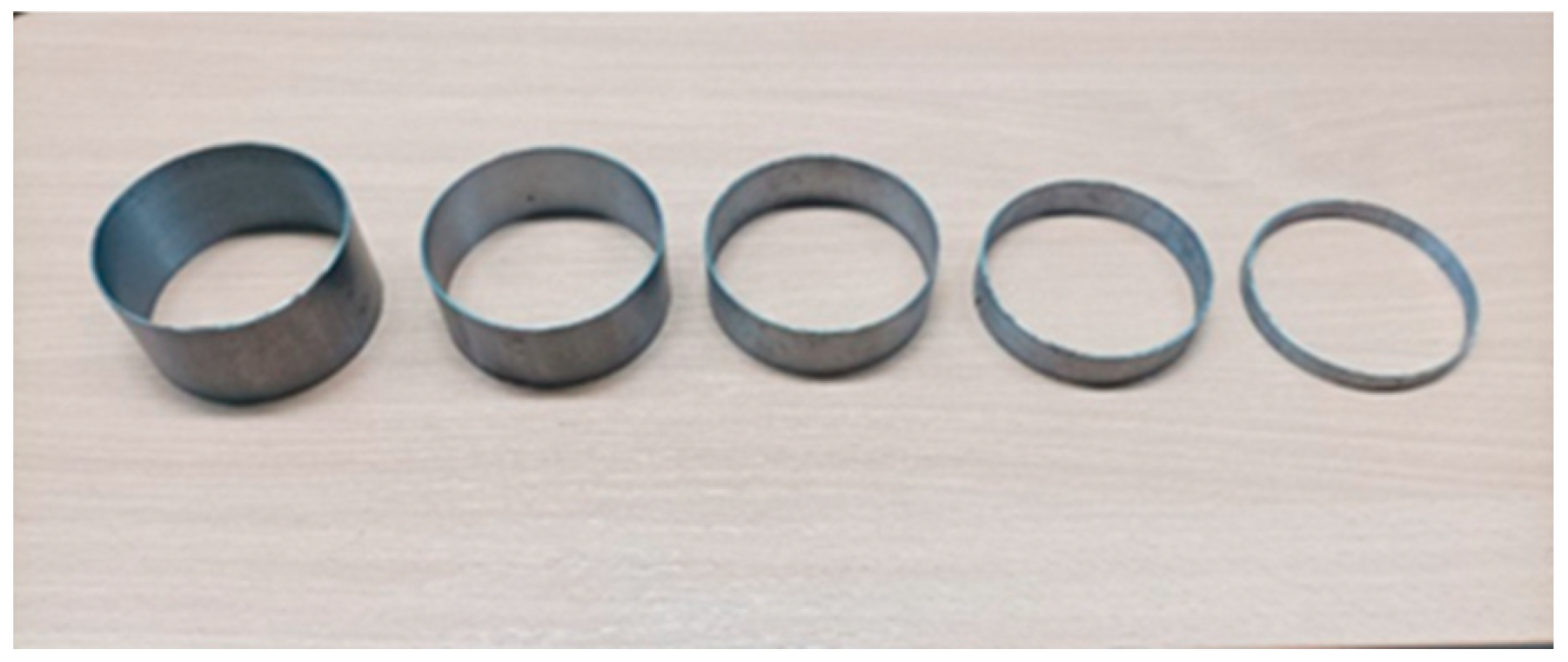
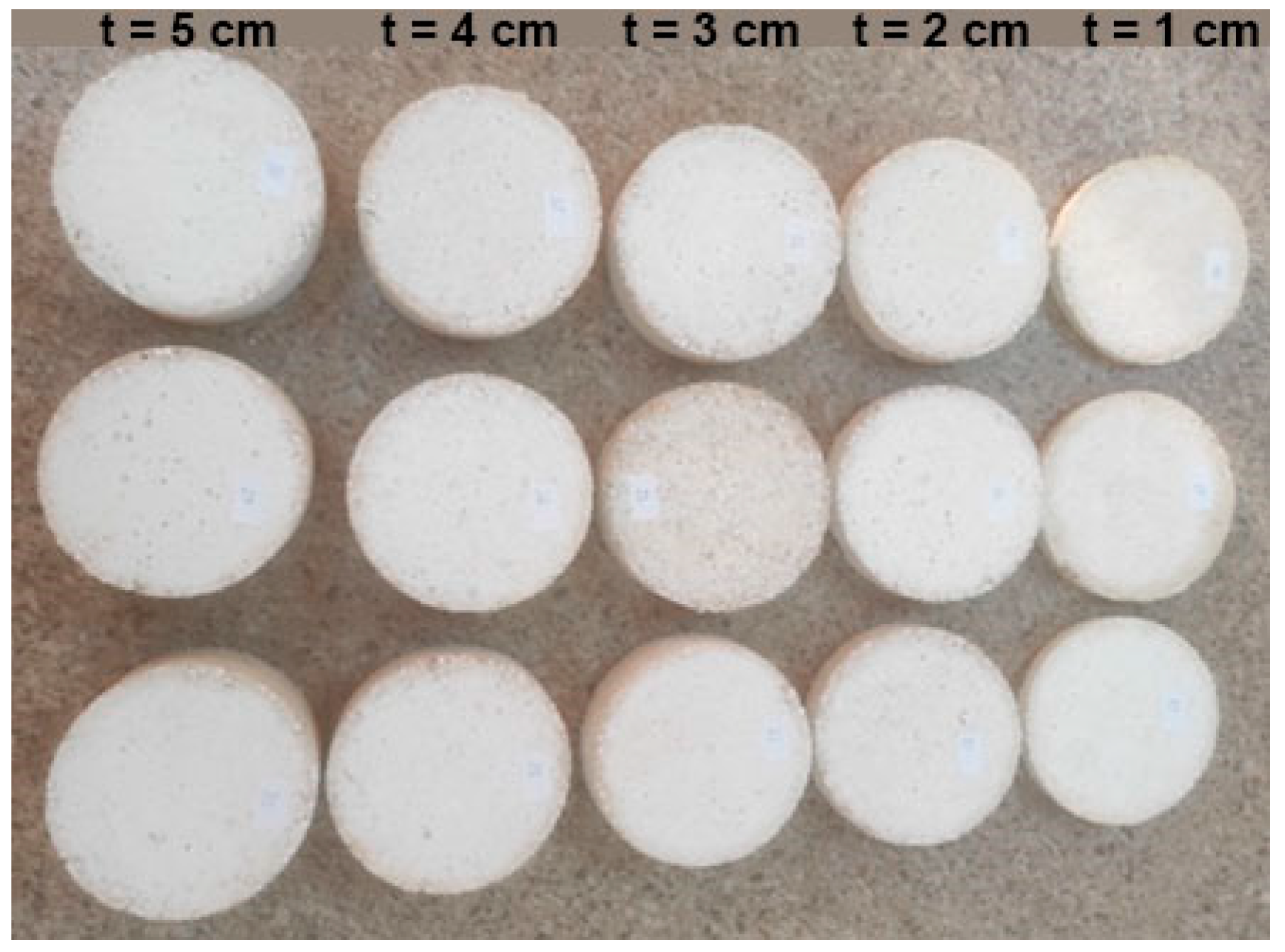
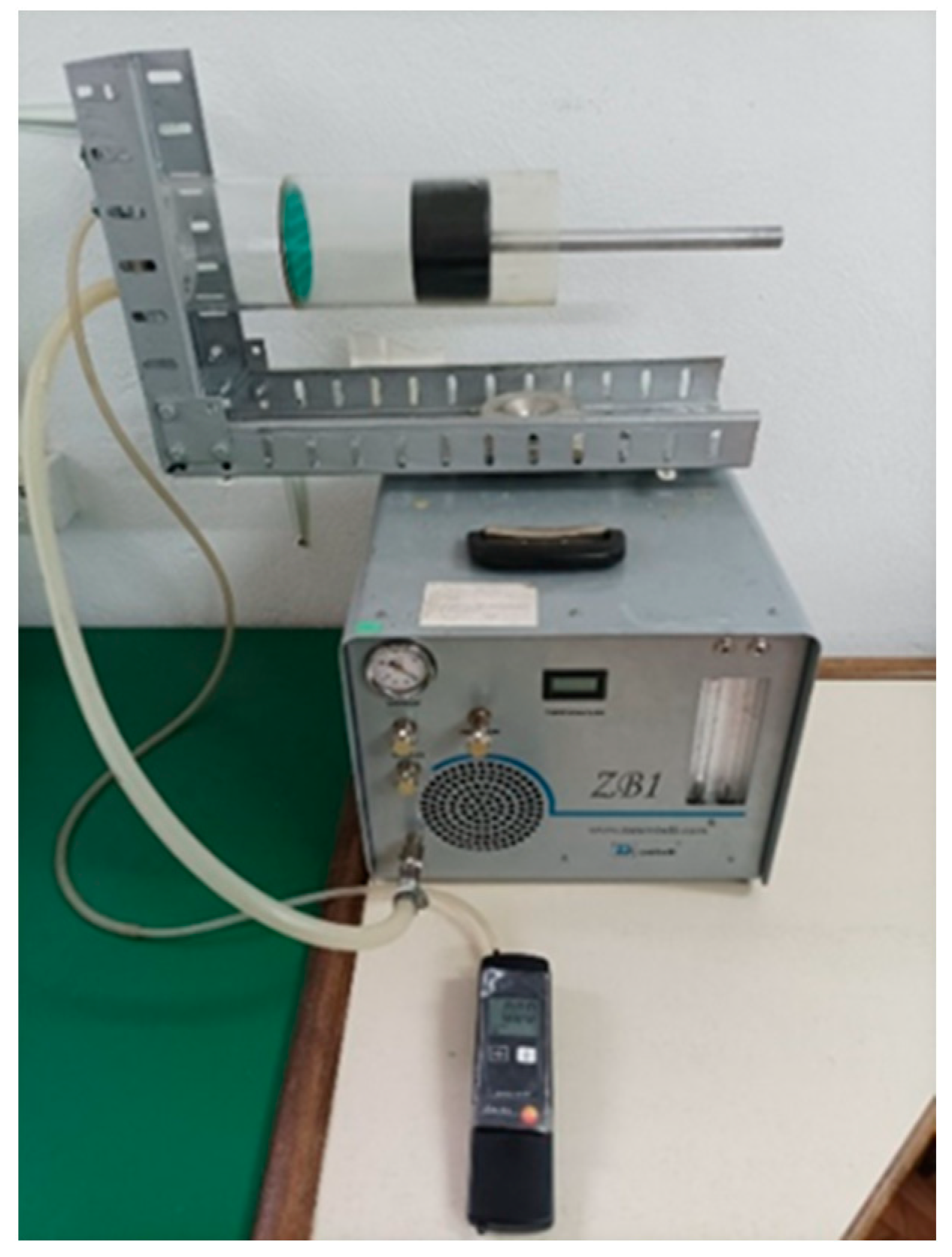
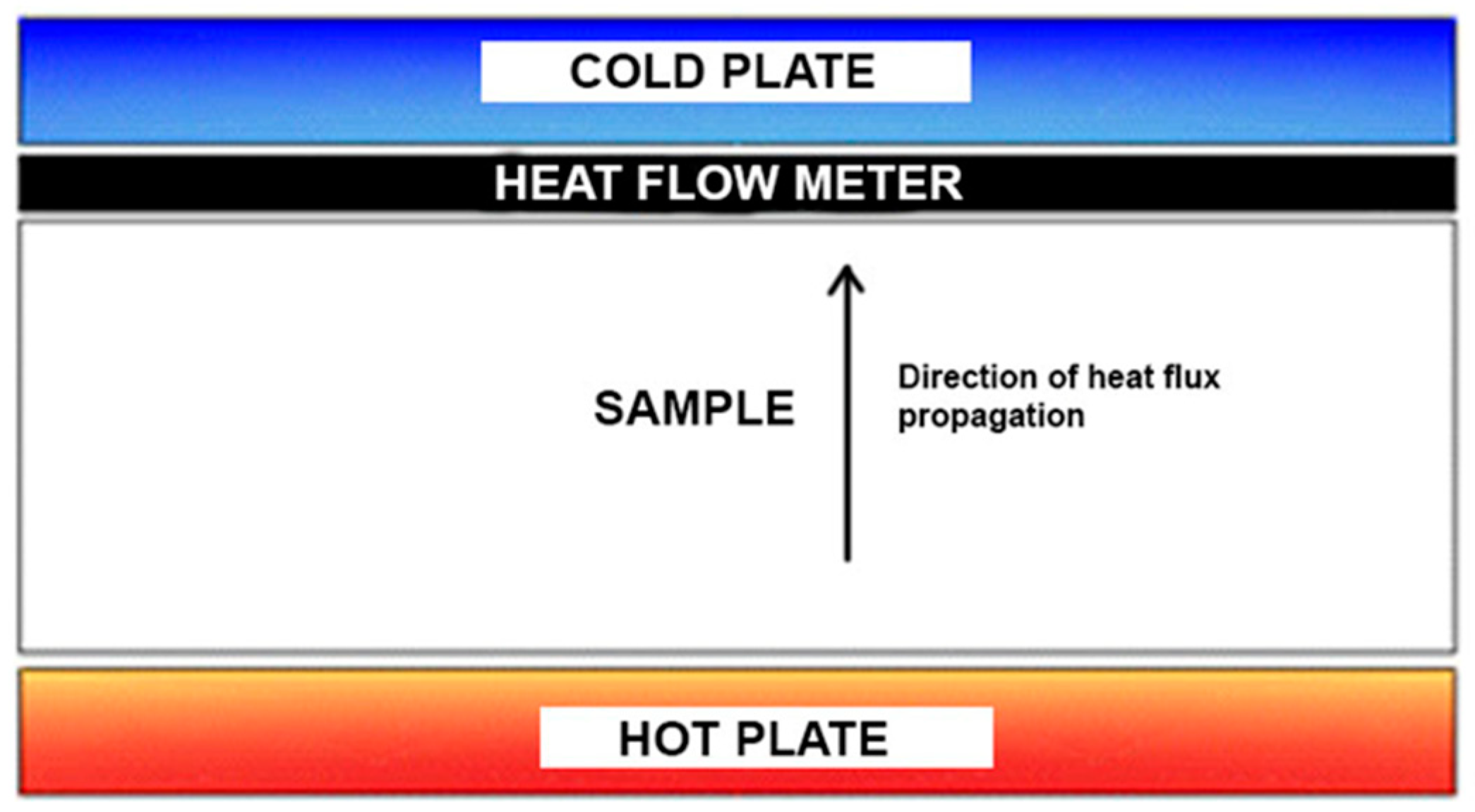
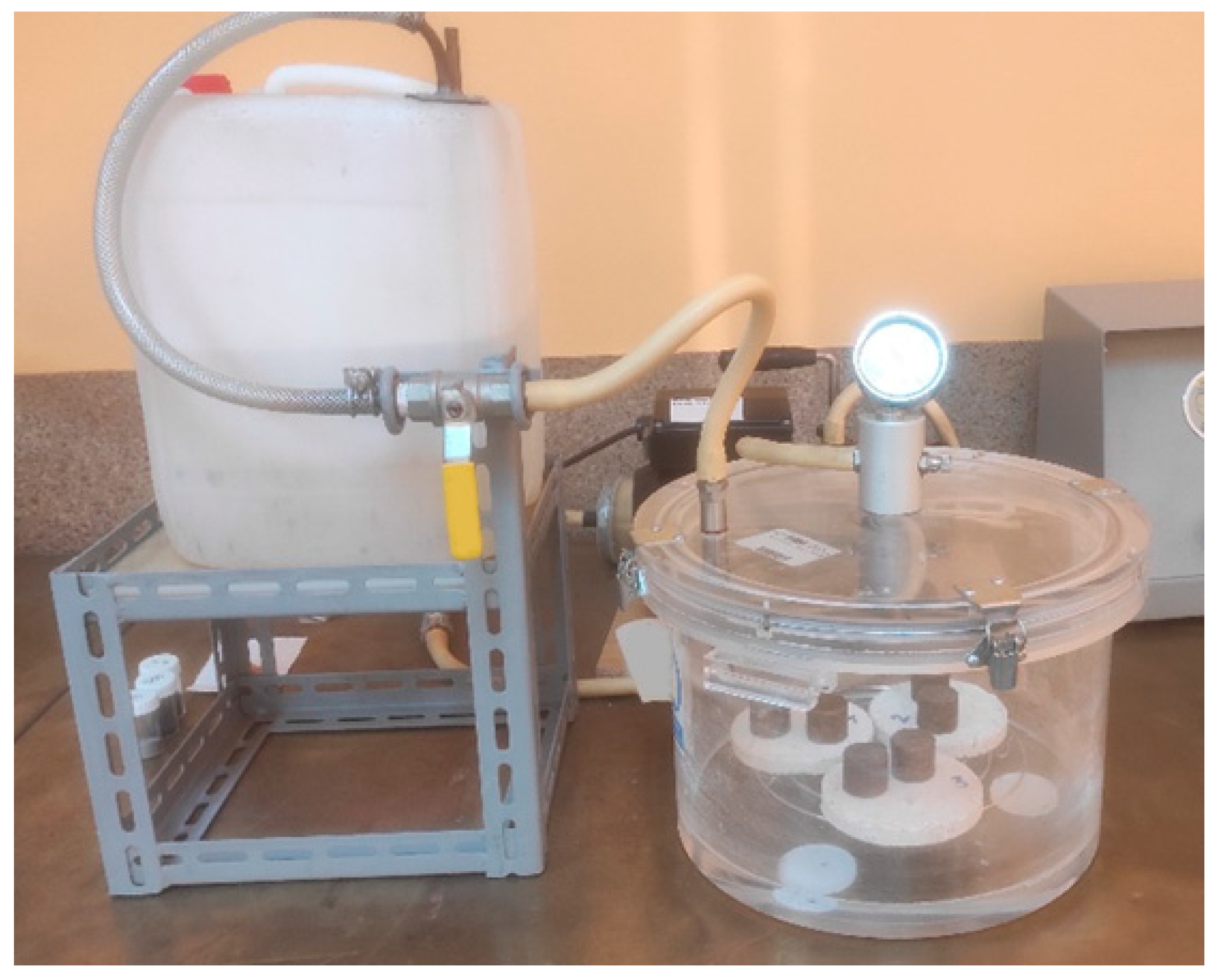
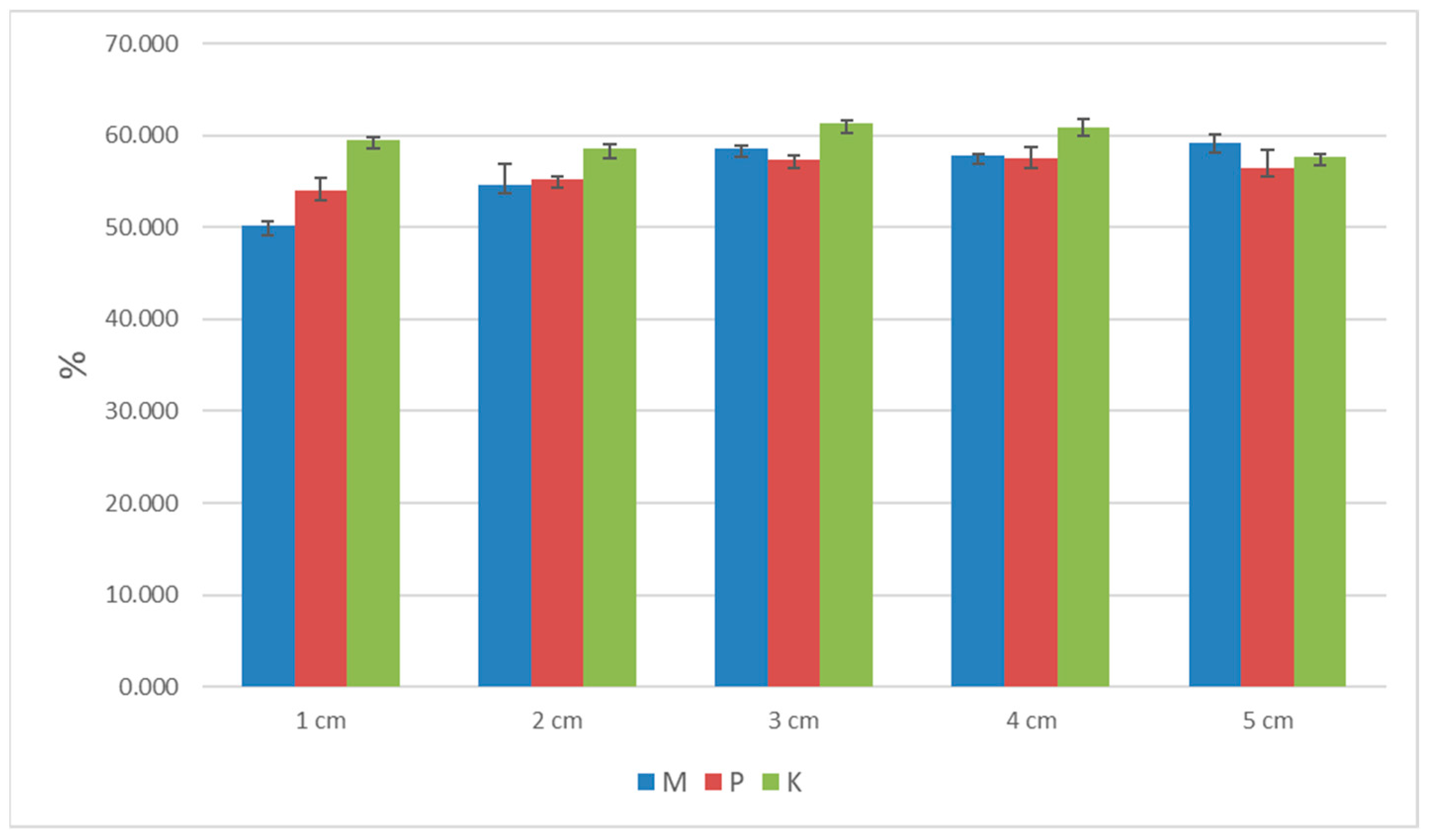
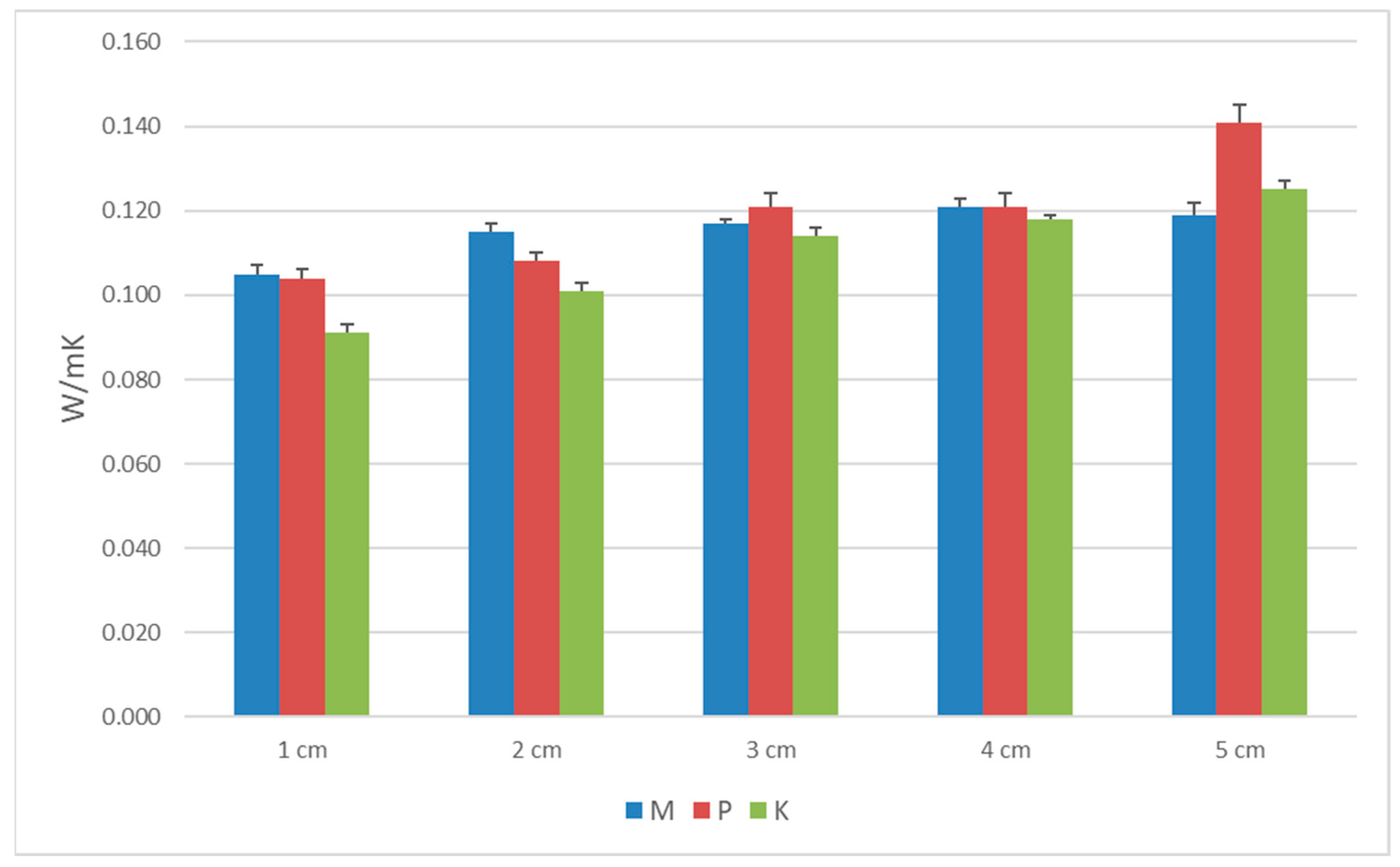
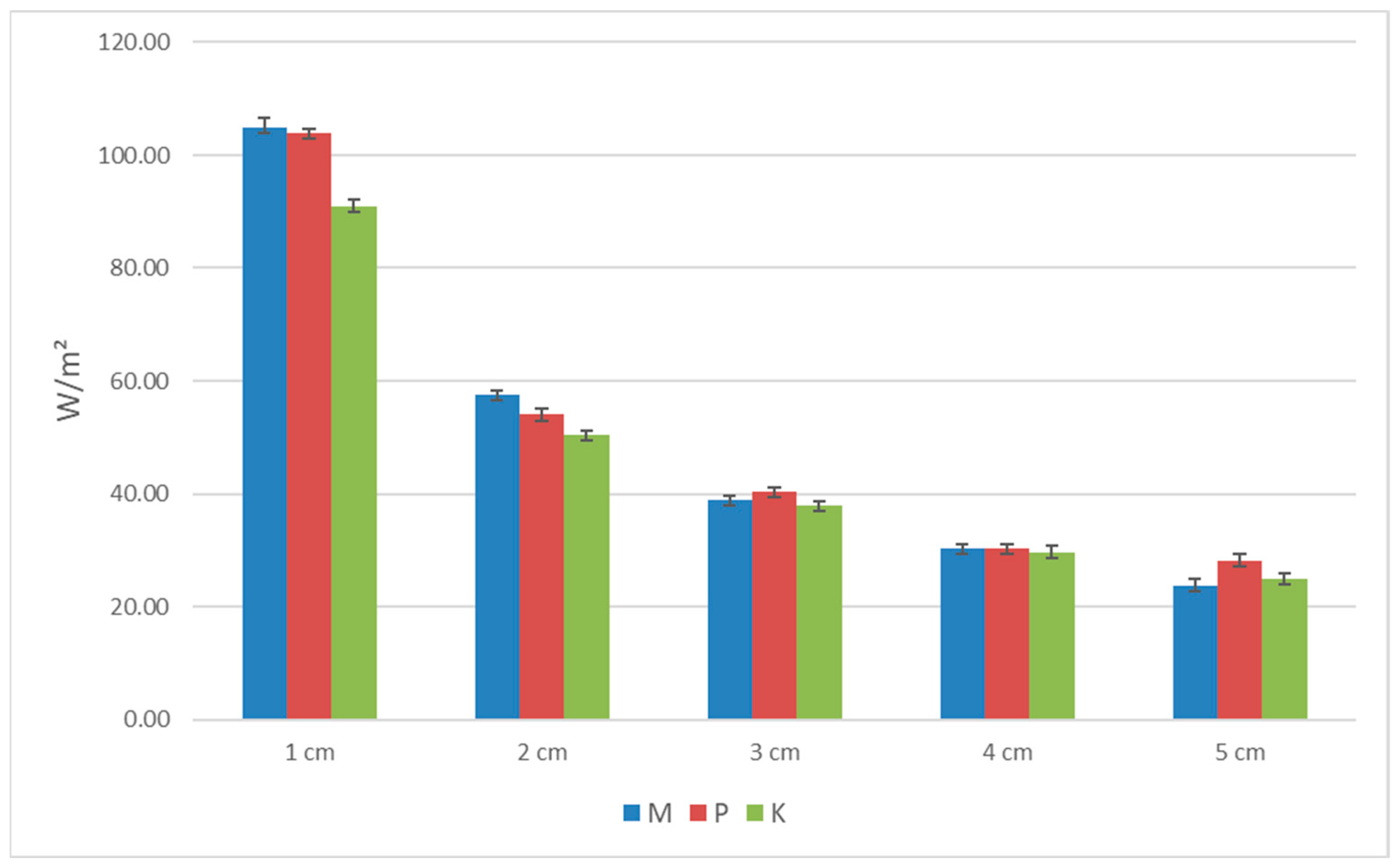

| Mark | Sample Thickness | Porosity | Volume Mass | Absorbing Water | Heat Flux | Thermal Conductivity Coefficient | Longitudinal Specific Resistance to Airflow |
|---|---|---|---|---|---|---|---|
| d (cm) | φ | γ (g/cm³) | Uv | q (W/m²) | λ (W/m∙K) | r (kPa·s/m²) | |
| M | 1 | 50.1 | 0.594 | 84.7 | 105 | 0.105 | 678.284 |
| P | 1 | 53.9 | 0.598 | 90.2 | 104 | 0.104 | 512.570 |
| K | 1 | 59.5 | 0.495 | 120.3 | 91 | 0.091 | 195.726 |
| M | 2 | 54.6 | 0.595 | 91.9 | 57.5 | 0.115 | 418.831 |
| P | 2 | 55.2 | 0.624 | 88.5 | 54 | 0.108 | 396.996 |
| K | 2 | 58.5 | 0.571 | 111.3 | 50.5 | 0.101 | 191.404 |
| M | 3 | 58.6 | 0.596 | 98.3 | 39 | 0.117 | 279.409 |
| P | 3 | 57.3 | 0.629 | 91.1 | 40.33 | 0.121 | 480.612 |
| K | 3 | 61.2 | 0.590 | 114.9 | 38 | 0.114 | 153.228 |
| M | 4 | 57.9 | 0.586 | 98.8 | 30.25 | 0.121 | 280.650 |
| P | 4 | 54.5 | 0.603 | 95.5 | 30.25 | 0.121 | 282.743 |
| K | 4 | 60.9 | 0.554 | 118.5 | 29.5 | 0.118 | 136.195 |
| M | 5 | 59.2 | 0.566 | 104.8 | 23.8 | 0.119 | 184.019 |
| P | 5 | 56.4 | 0.628 | 90.2 | 28.2 | 0.141 | 281.983 |
| K | 5 | 57.7 | 0.623 | 96.6 | 25 | 0.125 | 280.642 |
| Porosity for the Three Types of Biocomposites | ||||||
|---|---|---|---|---|---|---|
| d (cm) | Biocomposite M (%) | Std. Dev. | Biocomposite P (%) | Std. Dev. | Biocomposite K (%) | Std. Dev. |
| 1 | 50.144 | 0.466 | 53.920 | 1.451 | 59.528 | 0.289 |
| 2 | 54.632 | 2.193 | 55.230 | 0.326 | 58.523 | 0.463 |
| 3 | 58.582 | 0.306 | 57.354 | 0.490 | 61.242 | 0.360 |
| 4 | 57.877 | 0.070 | 57.458 | 1.317 | 60.908 | 0.828 |
| 5 | 59.177 | 0.966 | 56.447 | 1.923 | 57.714 | 0.210 |
| Thermal Conductivity for the Three Types of Biocomposites | ||||||
|---|---|---|---|---|---|---|
| d (cm) | Biocomposite M (W/m∙K) | Std. Dev. | Biocomposite P (W/m∙K) | Std. Dev. | Biocomposite K (W/m∙K) | Std. Dev. |
| 1 | 0.105 | 0.002 | 0.104 | 0.002 | 0.091 | 0.002 |
| 2 | 0.115 | 0.002 | 0.108 | 0.002 | 0.101 | 0.002 |
| 3 | 0.117 | 0.001 | 0.121 | 0.003 | 0.114 | 0.002 |
| 4 | 0.121 | 0.002 | 0.121 | 0.003 | 0.118 | 0.001 |
| 5 | 0.119 | 0.003 | 0.141 | 0.004 | 0.125 | 0.002 |
| Heat Flux for the Three Types of Biocomposites | ||||||
|---|---|---|---|---|---|---|
| d (cm) | Biocomposite M (W/m2) | Std. Dev. | Biocomposite P (W/m2) | Std. Dev. | Biocomposite K (W/m2) | Std. Dev. |
| 1 | 105.00 | 1.521 | 104.00 | 0.705 | 91.00 | 1.254 |
| 2 | 57.50 | 0.739 | 54.00 | 1.028 | 50.50 | 0.603 |
| 3 | 39.00 | 0.552 | 40.33 | 0.741 | 38.00 | 0.644 |
| 4 | 30.25 | 0.793 | 30.25 | 0.879 | 29.50 | 1.191 |
| 5 | 23.80 | 1.161 | 28.20 | 1.013 | 25.00 | 0.838 |
| Longitudinal Specific Resistance to Airflow for the Three Types of Biocomposites | ||||||
|---|---|---|---|---|---|---|
| d (cm) | Biocomposite M (kPa·s/m2) | Std. Dev. | Biocomposite P (kPa·s/m2) | Std. Dev. | Biocomposite K (kPa·s/m2) | Std. Dev. |
| 1 | 678.286 | 25.480 | 512.570 | 14.421 | 195.726 | 16.419 |
| 2 | 418.831 | 22.674 | 396.996 | 27.154 | 191.404 | 10.694 |
| 3 | 279.409 | 49.175 | 480.612 | 13.963 | 153.228 | 8.076 |
| 4 | 280.650 | 14.568 | 282.743 | 11.437 | 136.186 | 2.988 |
| 5 | 184.019 | 6.247 | 281.983 | 2.870 | 280.642 | 20.166 |
| Composite Mixture | d (cm) | An Alternative Serial Number | Longitudinal Specific Resistance to Airflow (kPa∙s/m2) | Heat Flux (W/m2) | Normalized Values | |
|---|---|---|---|---|---|---|
| Longitudinal Specific Resistance to Airflow | Heat Flux | |||||
| M | 1 | 1. | 678.284 | 105.00 | 1.00 | 0.00 |
| P | 2. | 512.570 | 57.50 | 0.52 | 0.58 | |
| K | 3. | 195.726 | 39.00 | 0.26 | 0.81 | |
| M | 2 | 4. | 418.831 | 30.25 | 0.27 | 0.92 |
| P | 5. | 396.996 | 23.80 | 0.09 | 1.00 | |
| K | 6. | 191.404 | 104.00 | 0.69 | 0.01 | |
| M | 3 | 7. | 279.409 | 54.00 | 0.48 | 0.63 |
| P | 8. | 480.612 | 40.33 | 0.64 | 0.80 | |
| K | 9. | 153.228 | 30.25 | 0.27 | 0.92 | |
| M | 4 | 10. | 280.650 | 28.20 | 0.27 | 0.95 |
| P | 11. | 282.743 | 91.00 | 0.11 | 0.17 | |
| K | 12. | 136.195 | 50.50 | 0.10 | 0.67 | |
| M | 5 | 13. | 184.019 | 38.00 | 0.03 | 0.83 |
| P | 14. | 281.983 | 29.50 | 0.00 | 0.93 | |
| K | 15. | 280.642 | 25.00 | 0.27 | 0.99 | |
| An Alternative Serial Number | Δoi | ξi (k) | γi | Rank | ||
|---|---|---|---|---|---|---|
| Longitudinal Specific Resistance to Airflow | Heat Flux | Longitudinal Specific Resistance to Airflow | Heat Flux | |||
| 1. | 0.00 | 1.00 | 1.00 | 0.33 | 0.67 | 3 |
| 2. | 0.48 | 0.42 | 0.51 | 0.55 | 0.53 | 12 |
| 3. | 0.74 | 0.19 | 0.40 | 0.73 | 0.57 | 9 |
| 4. | 0.73 | 0.08 | 0.41 | 0.86 | 0.63 | 7 |
| 5. | 0.91 | 0.00 | 0.35 | 1.00 | 0.68 | 2 |
| 6. | 0.31 | 0.99 | 0.62 | 0.34 | 0.48 | 14 |
| 7. | 0.52 | 0.37 | 0.49 | 0.57 | 0.53 | 11 |
| 8. | 0.36 | 0.20 | 0.58 | 0.71 | 0.64 | 5 |
| 9. | 0.73 | 0.08 | 0.41 | 0.86 | 0.63 | 6 |
| 10. | 0.73 | 0.05 | 0.41 | 0.90 | 0.65 | 4 |
| 11. | 0.89 | 0.83 | 0.36 | 0.38 | 0.37 | 15 |
| 12. | 0.90 | 0.33 | 0.36 | 0.60 | 0.48 | 13 |
| 13. | 0.97 | 0.17 | 0.34 | 0.74 | 0.54 | 10 |
| 14. | 1.00 | 0.07 | 0.33 | 0.88 | 0.61 | 8 |
| 15. | 0.73 | 0.01 | 0.41 | 0.97 | 0.69 | 1 |
Disclaimer/Publisher’s Note: The statements, opinions and data contained in all publications are solely those of the individual author(s) and contributor(s) and not of MDPI and/or the editor(s). MDPI and/or the editor(s) disclaim responsibility for any injury to people or property resulting from any ideas, methods, instructions or products referred to in the content. |
© 2023 by the authors. Licensee MDPI, Basel, Switzerland. This article is an open access article distributed under the terms and conditions of the Creative Commons Attribution (CC BY) license (https://creativecommons.org/licenses/by/4.0/).
Share and Cite
Bojković, J.; Marašević, M.; Stojić, N.; Bulatović, V.; Radičević, B. Thermal and Sound Characterization of a New Biocomposite Material. Materials 2023, 16, 4209. https://doi.org/10.3390/ma16124209
Bojković J, Marašević M, Stojić N, Bulatović V, Radičević B. Thermal and Sound Characterization of a New Biocomposite Material. Materials. 2023; 16(12):4209. https://doi.org/10.3390/ma16124209
Chicago/Turabian StyleBojković, Jovana, Miljan Marašević, Nenad Stojić, Vesna Bulatović, and Branko Radičević. 2023. "Thermal and Sound Characterization of a New Biocomposite Material" Materials 16, no. 12: 4209. https://doi.org/10.3390/ma16124209
APA StyleBojković, J., Marašević, M., Stojić, N., Bulatović, V., & Radičević, B. (2023). Thermal and Sound Characterization of a New Biocomposite Material. Materials, 16(12), 4209. https://doi.org/10.3390/ma16124209








